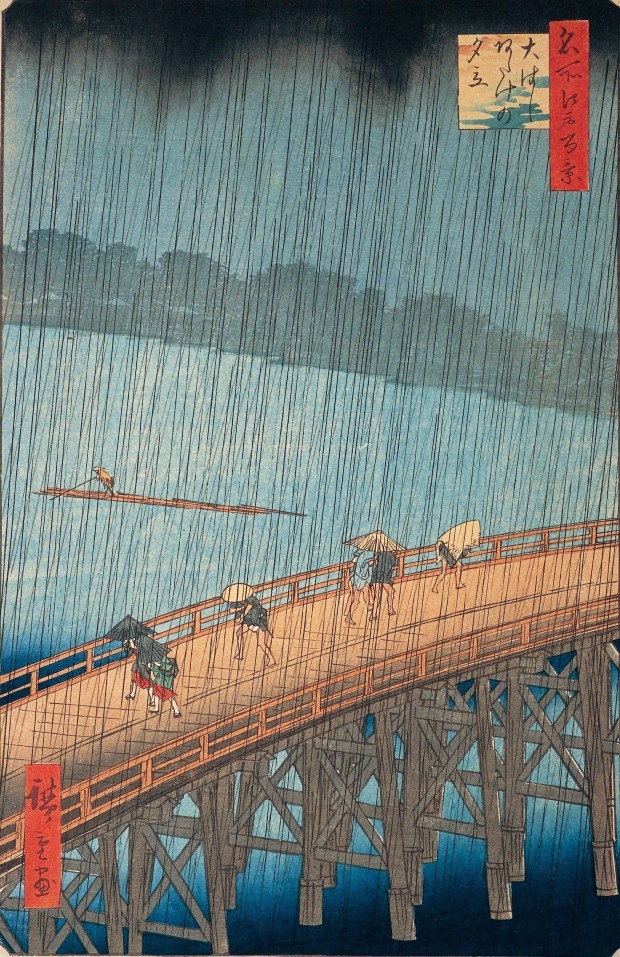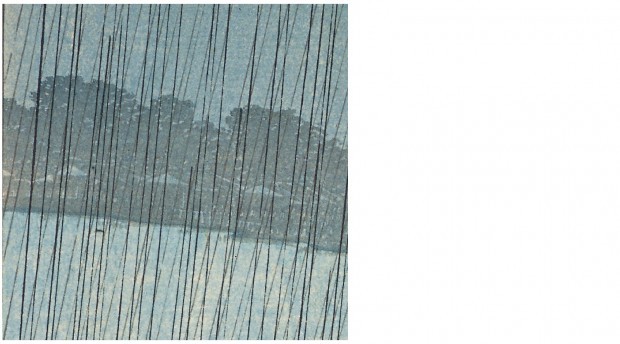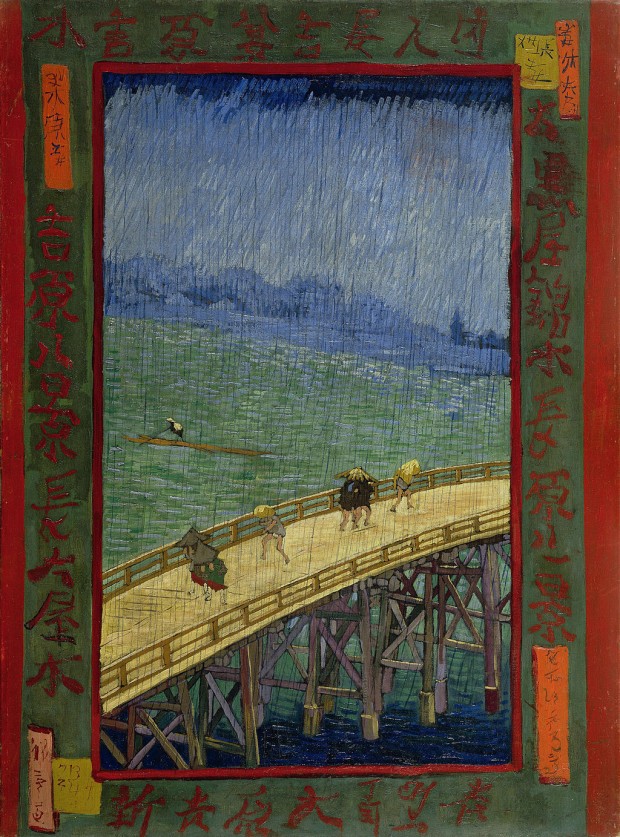This famous print has gone on to influence artists around the world as well as represent Japanese art to both Japanese and Western audiences. So what is the secret allure behind this work? Let’s find out!
A new point of view in One Hundred Famous Views of Edo
The hit series of woodblock prints 『名所江戸百景』 (One Hundred Famous Views of Edo), first published from 1856-1859, include several of the 浮世絵 (ukiyo-e) masterpieces by 歌川広重 (Utagawa Hiroshige, 1797-1858). Hiroshige began this project at the age of sixty, and in it, captured many charming scenes of 江戸 (Edo, 1603-1868, present day Tokyo) through very original, vertically-arranged compositions. Though he intended to create 100 images in the beginning, the overwhelming popularity of this series led the artist to produce a total of 118 prints over 3 years.
 Utagawa Hiroshige’s “Sudden Shower over Shin-Ōhashi Bridge and Atake” from the series, One Hundred Famous Views of Edo, multi-colored woodblock print, 1857, Takahama Tile Art Museum.
Utagawa Hiroshige’s “Sudden Shower over Shin-Ōhashi Bridge and Atake” from the series, One Hundred Famous Views of Edo, multi-colored woodblock print, 1857, Takahama Tile Art Museum.
Perhaps the most recognized and celebrated print among these works is 「名所江戸百景」 (“Sudden Shower over Shin-Ōhashi Bridge and Atake”). Hiroshige invites viewers to imagine a sudden onslaught of an evening rain shower in his lyrical depiction of a rainy scene at the Sumida River. The image features a section of the Ōhashi bridge, which spans the Sumida River in the Atake district, placed diagonally across the foreground of the composition. You may notice that the riverbank and the bridge form oblique lines, and the intersection of these elements creates an unusual configuration.
Taking a closer look at the bridge, several people are seen scurrying across while attempting to shield themselves against the deluge with umbrellas, hats, and a straw cape. Meanwhile, in the background, a lone boatman can be seen punting his raft of logs towards the shelter of the Fukagawa timber yards. The opposing movements of the horizontally dashing figures and floating boat contrasted with the vertically falling rain create a dynamic tension.
Hiroshige’s supporting actors, the engraver and the printer
Producing woodblock prints in the Edo period (1603-1868) required teamwork. Aside from Hiroshige’s compositional talents, the technical prowess of the engraver and printer also shine in “Sudden Shower over Shin-Ōhashi Bridge and Atake.” When creating the design for the print, Hiroshige’s idea to portray falling rain through both thin diagonal lines and a soft gradation of color created through layers of ink is quite ingenious. However, the ability to carve such fine parallel lines going in two different directions into the printing board attests to the engraver’s dexterity!

In addition, the equally difficult ほかし (bokashi) technique highlights the expertise of the printer. Bokashi is a woodblock printmaking technique in which a gradation of ink is applied by hand to a pre-moistened print block to create various values of a single color. Ink needed to be reapplied to the woodcut for each print made. This method of shading produced a sense of depth and can be seen in the dark rain clouds at the top of the print, as well as in the trees and faint outline of houses lined together along the bank in the background.

The Shin-Ōhashi Bridge was located further downstream from where it stands today, and was known to have an area of cheap housing near the embankment of the Sumida River during the Edo period. This detail along with the evening summer rain, a common seasonal occurrence, contribute to the charm of Hiroshige’s works.
A bold composition paired with delicate artistry
Hiroshige’s novel technique of dramatic cropping combined with his poetic treatment demonstrate the artist’s great talent, and also make this work one of his most representative pieces. This print alone went on to inspire many Western artists including many of the Impressionists. Hiroshige’s unique perspective is said to have influenced the many London bridge paintings by American artist James Abbott McNeill Whistler and of course, the Post-Impressionist artist Vincent van Gogh who made an oil paint copy of the print, in addition to numerous other artists.
Move the slider to compare Hiroshige’s original print and van Gogh’s copy.


(Left) “The Bridge in the Rain (after Hiroshige)” by Vincent van Gogh, oil on canvas, 1887. Public domain image. (Right) Utagawa Hiroshige’s “Sudden Shower over Shin-Ōhashi Bridge and Atake” credit same as listed above.
Translated and adapted by Jennifer Myers.












